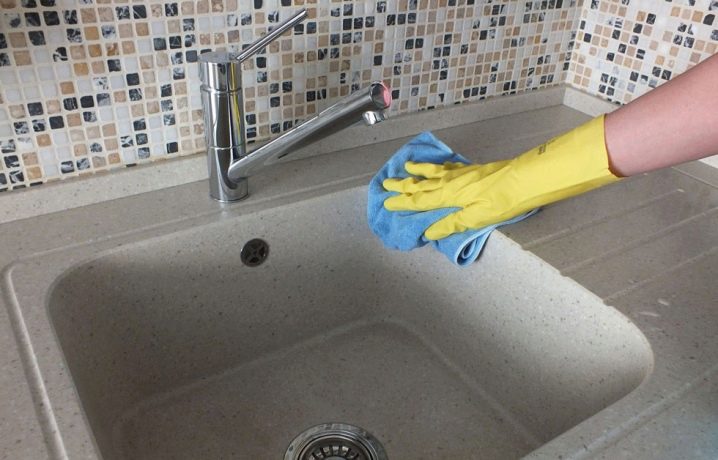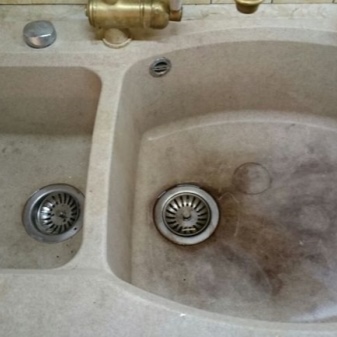How to clean ceramic and stainless steel sinks?

Each house has several sinks. Someone prefers to choose products from ceramics, someone like - from stainless steel. Over time, any shell acquires an unpleasant coating, stains appear, which are not always easy to remove.

Types and features of use
Today, in specialty plumbing stores, there is a wide selection of sinks, which are made from a variety of materials. Ceramic and stainless steel sinks are still the most popular and sought after. You can choose not only the material, but also the original shape of the sink. Before making your final choice, it is worth learning a little more about using the sink at home and about the difficulties that may arise during use and cleaning.

When choosing a ceramic sink of a light shade, you should be aware that such products change their color very quickly if you pour out the remnants of morning coffee, peel beets and more. If everything is not washed off immediately, then the plumbing object will absorb the paint and stains will remain. Dark colored shells are slower and often stained.
But, if the water in the house is hard, then limescale may well appear, which is clearly visible against a dark background.


During use, be sure to ensure that the tap does not leak, otherwise rust grooves will appear on the light ceramic surface, which is not so easy to remove. In addition, it is worth paying attention to the fact that ceramic products, due to improper operation, can become covered with cracks, into which dirt will clog and not only. All this will spoil the appearance of the sink. You should be especially careful with such plumbing items, do not drop heavy objects, do not pour boiling water.

Detergents
In order to clean the ceramic sink, you can safely use a variety of detergents. It is advisable that it is not a powder in order to avoid invisible scratches that are left by almost all abrasive products. It is recommended to choose gel and other liquid products. Also, when cleaning this type of sink, do not use hard metal sponges. Before you buy and clean the sink with a special tool that is sold in a store, you should definitely read the instructions. You need to be sure that this product is suitable for cleaning ceramic sinks.



These products are best applied to a warm surface. Before using a special detergent, it is recommended to fill the sink with warm water and leave it there for 15–20 minutes. After that, you should drain the water and you can start cleaning, which must be carried out with gloves so as not to damage the skin of the hands. The best way to clean the ceramic surface is with a soft sponge. If necessary, leave the applied product for 10-15 minutes, then rinse.
The stainless steel sink is very popular, especially for installation in the kitchen.

It does not darken, no plaque forms on its surface, and no traces of rust remain. However, it also needs proper care and proper cleaning. It is not recommended to use metal brushes and nets to clean stainless steel products in order not to damage the surface. Otherwise, scratches will remain forever.
Routine cleaning of such a sink can be done easily. For this you do not need any special products, a detergent for washing dishes will be enough. First you need to fill the sink with warm water, add a few drops of detergent and foam everything well. Then, using a regular sponge or soft brush, go over the entire surface of its inner part. Thoroughly clean the bottom and walls, then drain the water and rinse the surface of the sink with cool water.




Traditional methods
In order to clean a stainless steel or ceramic sink, it is not necessary to go to the store for special detergents. For cleaning, improvised tools that are in the kitchen cabinets of every house are quite suitable.

A ceramic sink can be completely cleaned with vinegar and baking soda:
- First, be sure to slightly warm up the vinegar. This can be done simply and safely. Pour a tablespoon of regular vinegar into a small container, place it in a bowl of hot water and after a minute the vinegar is ready to use.
- Next, add a small amount of baking soda to the heated vinegar, which is used for baking. You need so much soda to make a thick slurry, which will be a home remedy for cleaning.
- The mixture should be applied to the sink bowl, gently spread with a sponge over the entire surface, and left for 10 minutes. Then rinse with cold water.



There is also another effective folk remedy for which you need vinegar and soda. If there is no table vinegar in the house, then it can be easily replaced with ordinary citric acid:
- It is necessary to close the sink drain, having previously moistened it with warm water.
- Pour baking soda on the bottom and sides. Especially on areas that need to be thoroughly cleaned.
- Pour everything with one bottle of table vinegar or the same amount of diluted citric acid. After a second, you can hear a hiss - this is the reaction of baking soda and vinegar.
- After the hissing stops, you need to carefully rub the sink with a sponge, after 5 minutes you can wash everything off with cold water.




Get rid of plaque and stains
Sinks located in the bathroom or kitchen are covered with a layer of limescale due to too hard tap water, which is not easy to clean. In particular, plaque is clearly visible on black items. But on the white sinks, rust is clearly visible, which just cannot be washed off with water. Every housewife should know the secrets to easily get rid of plaque, dark spots and other contaminants.
Plain table vinegar is great for removing plaque.


It is only necessary to remember that it should not be acetic acid, which, as a rule, is seventy percent. If you have exactly acid at hand, then it must be diluted with water. Vinegar should be applied to areas that are covered with bloom and left for 10 minutes. It is best to apply this folk remedy with a spray bottle. Then rub all problem areas with a regular sponge and dishwashing detergent. The limescale must disappear.
Also ammonia perfectly relieves plaque. A few drops of ammonia should be diluted in a glass of water, then the sink should be treated with this liquid. Leave the sink like this for 10 minutes and then rinse. This product, when applied to stainless steel products, gives the sink a shine.
Plain mustard powder is also very good at helping with plaque and rust. It needs to be diluted to a thick paste, then applied to the surface, spread and left for a while. Then just rinse off with warm water.


If a stain appears on the white surface, bleach will help. For example, if brilliant green has dripped onto the sink or bright juice is poured, then it must be immediately filled with warm water, a small amount of bleach added there, left for half an hour, then the water must be drained.If necessary, stains can be treated with the same bleach that is applied simply to the sponge. All of the above methods help fight plaque, rust and stains.

Just remember that it is imperative to work with gloves.

Prevention and care
In order for the sink to delight every day with the brilliance of its impeccable cleanliness, it is necessary to adhere to several rules:
- In order not to spend a whole day fighting stains and plaque, it is recommended to take care of the sinks daily.
- After washing dishes and other manipulations, it is recommended to immediately clean the surface with detergent. If you do this every time, then a greasy deposit will not form in the sink, which will protect the metal or plastic pipe from clogging.
- It is best to dry the ceramic coating thoroughly overnight so that no water stains remain, which gradually turn into plaque. If, nevertheless, there are stains, drips from water, then they can be easily removed with a sponge and window cleaner.




- If a stain appears in the sink, then you need to get rid of it immediately. This can be done quickly and easily with baking soda, starch, or vinegar. You can choose any of the above methods.
- Do not soak the dishes in the sink for a long time, because this leads to its rapid contamination.


To learn how to successfully clean your stainless sink, see the video below.













The comment was sent successfully.